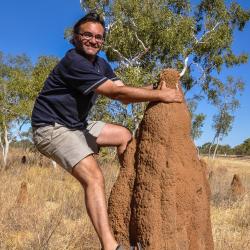
Romain GARROUSTE



45 rue Buffon
CP50
75005 Paris
Partcipation à la gestion des collections d’Arthropodes terrestres (insectes) : petits ordres
Collections numériques (Sonothéque et Médias)
Un module du Cours de l’école doctorale « utilisations innovantes des collections »
organisé pour la première fois au Parc Zoologique de Paris


Les participants au module le 27/03/2025

Un pensionnaire du PZP
Sous la direction de Roseli Pellens, ce module accueille des doctorants et des professionnels des Musées depuis plusieurs années. Pour la première fois, à l’initiative de Romain Garrouste (cours sur la photographie et l’imagerie en zoologie) une journée est consacrée à l’innovation dans les collections vivantes (recherche, médiation, pédagogie et conservation de la nature) et permet de découvrir ce zoo unique et ses relations avec les autres entités du MNHN, au service de toutes les missions de l’établissement et bien inséré dans des réseaux internationaux de conservation ex situ et in situ. Ces derniers aspects ont été dévellopés lors d’une conférence du Dr Alexis Lécu, directeur scientifique du PZP.
–
Enseignant au master SEP
–
Tuteur de master 1 et 2
–
Encadrement doctoral
Presentation
Mes travaux concernent l’évolution, l’écologie et la conservation des insectes, en utilisant des méthodes modernes de la taxonomie et de la systématique, y compris l’imagerie scientifique high tech 2D et 3D (CT-scan et imagerie synchrotron), la morphométrie, la biologie fonctionnelle, l’analyse de données multivariées et l’exploration de la biodiversité et de la paléodiversité. Pour cela je participe et organise des missions de terrain (plus de 20 pays) et je suis inventeur et co-inventeur de nouveaux gisements fossiles en France, Espagne, Nouvelle-Calédonie, Madagascar, Svalbard, etc. J’ai participé à la création de l’Antenne du Muséum en Guyane française où j’ai représenté le Muséum.
J’exerce également une expertise en biologie et écologie de la conservation, notamment au sujet des espèces invasives et j’ai une activité en diffusion des connaissances, comprenant des enseignements. J’ai également une activité de gestion des collections (chargé de conservation petits ordres d’insectes) et en valorisation (collections numériques, phénotypage haut-débit 3D, bioinspiration).
My work focuses on the evolution and ecology of insects, using modern methods of taxonomy and systematics, including high tech imaging (2D and 3D), morphometrics, functional biology, multivariate data analysis and exploration of biodiversity and paleodiversity. For this I participate and organize field missions and I’m inventor and co-inventor of new fossil deposits in France, New Caledonia, Madagascar, Svalbard, etc. I also have expertise in conservation biology and ecology, collection curation (insects) as well as teaching and popularizing.
–
Des fourmis bien armées pour récolter du nectar (mars 2023)
Les secrets aéronautiques des libellules (février 2023)
Dans les Alpes, les loups chassent le mouflon (janvier 2022)
Images de science : la vie reprend, un an après le feu dans le massif des Maures (septembre 2022)
(Re)lisons « Écotopia », utopie visionnaire pour dessiner le monde d’après (novembre 2021)
Images de science : Connaissez-vous la punaise aux œufs d’or ?(novembre 2021)
Pourquoi, malgré les flammes si proches, les cigales continuent de chanter (aout 2021)
Dans le Var, face à l’incendie qui détruit l’un des joyaux de la biodiversité européenne (aout2021)
Débat scientifique sur le déclin des insectes : que reste-t-il à prouver ? (janvier 2021)
La taxonomie, cette discipline essentielle à la compréhension des pathogènes (juin 2020)
Petit guide pour apprentis naturalistes confinés (avril 2020)
Impact écologique des feux : et les insectes ? (janvier 2020)
Une redoutable bactérie disséminée par des insectes : Xylella
À l’automne, les punaises arrivent en ville… et aux champs (septembre 2019)
Dépasser sa peur des espèces invasives grâce à la science citoyenne (juin 2019)
Rentrée 2018 très invasive pour la punaise diabolique (novembre 2018)
Une exoplanète à notre portée : la Terre (juillet 2018)
Les charmes discrets des insectes fossiles (juin 2018)
Les Français n’aimeraient-ils ni les insectes, ni la nature ? (mai 2018)
Scène de crime : quand les insectes mènent l’enquête (mars 2018)
Crise de la biodiversité : n’oublions pas les invertébrés ! (octobre 2017)
Des explorateurs de science à la rescousse de la planète (septembre 2017)
La réalité virtuelle pour mieux apprécier les sciences du vivant (mai 2017)
Des punaises nommées d’après l’univers de Tolkien (mars 2017)
French wildfires have destroyed one of the most unique biodiversity hotspots in Europe (aout 2021)
An exoplanet within arm’s reach: the Earth (aout 2019)
The city-loving ‘devil bug’ lands in Paris… and continues its march around the world (avril 2018)
Everything you never wanted to know about bed bugs, and more (juillet 2018)

FRANCE 5 - DOCUMENTAIRE - Mystérieux insectes, sur la piste des origines (Février 2023)
Le Blob - Cité des sciences (janvier 2020) Le printemps silencieux des insectes
France Culture - Le Direct La méthode scientifique - Vol : l’évolution à tire-d’ail
–-
Guyane
Madagascar
Nouvelle Calédonie
Svalbard
Afrique du Sud
Espagne
France (région Sud, Occitanie, etc.)